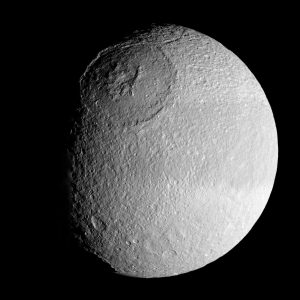
Tethys is the fifth-largest moon Saturn, with a mean radius of 531 km (330 miles), or about 0.3 times the size of the Earth‘s Moon.
Tethys is made almost entirely of water ice, giving it the lowest density of any of the solar system’s major moons. This also gives Tethys a bright surface, which is covered by impact craters. The largest of these is around 445 km wide and known as Odysseus.
The surface of Tethys is also covered in fault lines known as ‘graben’, the largest of which, Ithaca Chasma, is about 100 km wide and runs nearly three quarters of the way around the moon’s circumference – over 2000 km. Ithaca Chasma is concentric to the Odysseus crater and may have formed at the same time, although it appears to be older than Odysseus, based on crater counts. Another, more likely, hypothesis is that Ithaca Chasma was formed when Tethys’s interia solidified, expanding and cracking its surface in the process.
Tethys was discovered in 1684 by Giovanni Domenico Cassini, who also discovered Rhea, Dione and Iapetus. Along with Titan, these largest of Saturn’s moons are all visible through a good small telescope.